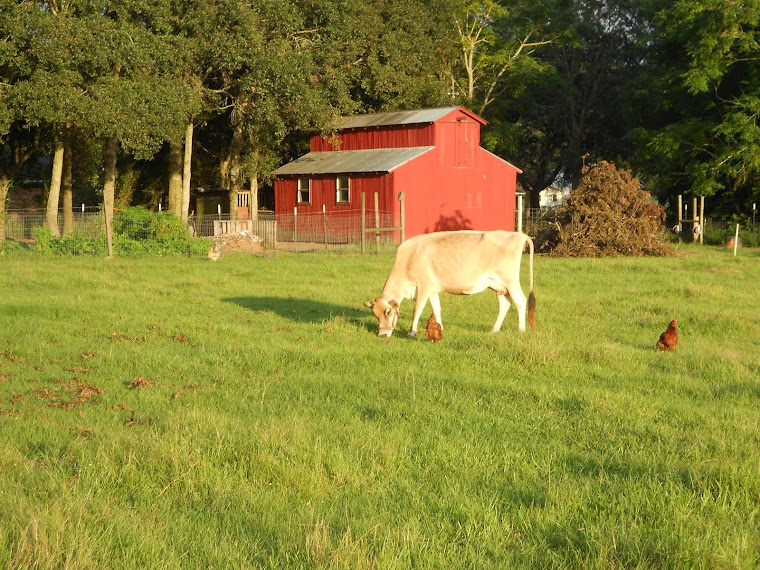Timely rains coupled with the positive effects of the first year in 24 that we limed the pasture resulted in plenty of grass in our pasture. We are a small homestead farm, raising animals to primarily feed our family. Allan Nation, of Stockman Grass Farmer, once said, "Don't measure success by acres owned or animals counted-measure it by the health of your soil, the resilience of your land and the life it sustains." In short, he's saying, you're not an animal farmer, you're a grass farmer!
When grass stops growing, you've got to still have grass in a stockpile. We do that by purchasing hay. Each year we buy hay from two sources - a neighbor down the road grows good Bermuda hay that he primarily grows for horses. It is usually clean and the cows and goats enjoy eating it in the cold days of winter when there's not a green blade growing. We also buy round bales from a rancher who grows quality Bermuda hay and follows the principles of Allan Nation, resulting in the production of reliable hay.
We got the call from the neighbor growing round bales that they would be baling the following afternoon. If we pick it up behind the baler, it's $7 per bale. If we pick it up from their barn, it's $9 per bale. You already know which option we chose. It's funny how things change in a year. Last year, following my heart surgery, I was out of commission, unable to lift hay. My Dad, my brother-in-law, my sons, my wife, and my brother-in-laws sons had my back - literally, as they got the hay in the barn. This year, all healed up, Tricia and I hooked up the cattle trailer and made the mile drive to the neighbor's hay field. They had started baling at 12:30 pm and had around 100 bales already on the ground.
This year, the neighbor had a new baler. The bales were smaller, but tightly packed. I liked the fact that he had affixed Old Glory to the back of his baler and the flag was blowing in the wind. I'm glad to give my money to Patriotic Americans proud of their country and still working and enjoying an agricultural way of life. We had originally purchased from the neighbor's grandfather, who has now passed on, but his grandson picked up the hay baling responsibilities and was carrying on the responsibilities.
Tricia drove the truck. It is a 2000 model Toyota PreRunner with 254,000 miles still going strong. It still blows cool air, and that's important for the driver, my wife, who wasn't enthused about me trying to get a photo of her.
She was pulling the cattle trailer. I think it is a 1976 model, originally painted a goldish-yellow color, and was my grandfather's. It has some rust and is showing its age, but it still gets the job done. As Tricia drove between the bales, my job was to load the trailer with bales of hay. The hay had been cut the day before, cured in the sun, fluffed and now, it was baled.
We still have 16 square bales from last year, so according to our calculations, we'd need 60 bales to get our inventory where we want it to be in the hay loft. We got our 60 bales loaded in just under 30 minutes, paid the neighbor, and drove back to the house.
The job was far from over though. Now, we had to get it up in the loft. We backed the trailer up to the barn, affixed the pulley and rope to the 4x4 that is positioned over the door. The rope has a bungee cord with hooks on one end. I lower the rope, Tricia hooks a hay bale on and I pull it up to the loft. The other end of the rope has a circle on it. When I pull it up, I put the circle over a nail I have driven in a rafter.
The sun was going down and we had to work fast.
With the circle over a nail, the bale is held in place, allowing me to run to the edge and unhook the hay bale.
We count as we go and before the sun went down, the 60th bale came up the pulley!
We had previously dropped down the 16 bales still remaining from last year's crop into a stall in the barn. Using LIFO (last in first out) accounting method, we'll use the old hay first in feeding this winter.
All the hay is packed nicely up in the loft. We can get 3 bales stacked across and four high or 12 bales per stack. It fits snugly, but nicely up there.
It was good to get the job done. Tricia and I slept good that night. After a hard day's work, a sound sleep in a comfortable bed is a relaxing and rewarding experience. You put up stores while the weather is nice in preparation for upcoming days when the weather won't be nice. Joseph did this same thing in Genesis when he put up grain in the 7 years of plenty in preparation for 7 years of famine that would affect Egypt and surrounding countries. God gave him wisdom and in so doing, many lives were saved. You gotta make hay while the sun shines.













No comments:
Post a Comment